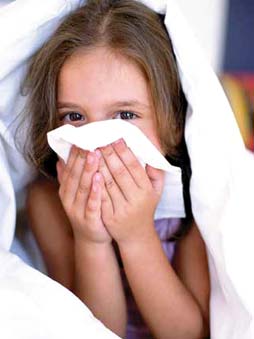Health > Kids > Allergies In Children
ALLERGIES IN CHILDREN

Every child care center usually has at least one child who suffers from allergies. As a result, it is important for caregivers to be aware of children's allergies, know how to avoid substances that trigger allergies and be prepared to manage reactions.
Substances found in our everyday lives are not normally harmful (e.g. pollen, peanuts, feathers and animal dander). These substances (called allergens) enter our bodies through breathing, eating, touching or being stung. Once an allergen has entered our bodies, the immune system responds by producing antibodies that attack the allergen. These antibodies remain in the body to protect the person the next time he/she is exposed to the allergen. This is the same way people usually develop life-long protection (i.e. immunity) from chickenpox once they have had the illness.
However, for people with allergies, repeated exposure to an allergen causes their immune systems to become overly-sensitive, rather than immune, to a particular allergen. An allergic reaction occurs when a person is exposed to an allergen and the body produces chemicals (such as histamine) that injure body tissues and cause allergic symptoms to develop. Allergies can be mildly annoying or they can cause severe reactions. Fortunately, most allergies are not life-threatening. The following table lists the allergens that are responsible for allergic reactions.
| Common Allergic Substances |
Typical Reactions |
Environmental
dust, mould, pollen, grass and trees |
itchy eyes and nose, nasal discharge, blocked nasal passages, sinus headache, sneezing, wheezing, coughing and shortness of breath
|
Animals and Birds
fur and feathers |
itchy eyes and nose, nasal discharge, etc. |
Insects
stings from bees and wasps |
wheezing, hives, swelling of upper airway with difficulty breathing, swelling of face and anaphylactic shock in extreme cases |
Foods
eggs, peanuts, nuts, shellfish, milk and
wheat (the latter two are common in infants) |
vomiting, diarrhea and bloody stools, plus symptoms as for insect venom* (such as hives, pallor, weakness, difficulties breathing and collapse). |
Medications and Chemicals
medical (e.g. antibiotics) and non-medical
(e.g. fabric softener) |
any of the above reactions |
Allergic reactions usually occur within four of the body's systems: the upper and lower respiratory tract, skin, eyes and gastrointestinal tract. The more body systems that are affected by an allergen, the more severe the allergic reaction. Anaphylactic shock, a potentially life-threatening allergic reaction, affects the entire body. This reaction can happen very quickly. Within seconds, the child's eyes, lips and face will begin to swell; a headache will develop; hives may appear all over the body; the throat may swell, thereby cutting off breathing; and vomiting and diarrhea may occur. Within ten minutes, the child can become unconscious. Caregivers must identify these symptoms immediately, administer the child's adrenalin (to counteract the attack) and call an ambulance. Anaphylactic shock is most commonly caused by peanuts, nuts, eggs, shellfish, bee and wasp stings, penicillin and aspirin. Even if caregivers are not sure about the child's symptoms, they should always administer the child's adrenalin and call an ambulance. Parents who have children with severe allergies should be encouraged to obtain medical alert bracelets for them and ensure that they are worn at all times.
There is no cure for allergies. Instead, caregivers must do their best to prevent reactions by eliminating or minimizing children's exposure to allergens. Treatment consists of alleviating or reducing the effects of the symptoms (e.g. runny noses, itchy red eyes, nasal and sinus congestion), usually with medications such as antihistamines and decongestants.
Preventing Allergic Reactions
Effective communication between caregivers and parents is essential if allergic reactions are to be avoided. When enrolling a child, caregivers should ask parents about allergies, including the names of any allergens, a list of specific symptoms, ways of preventing exposure to allergens, actions that should be taken if a reaction occurs and any drugs that have been prescribed or recommended by the child's physician. Caregivers can then use all of this information to develop an allergy care plan that meets the child's specific needs. The "Allergies History Form" in Well Beings is recommended for use in child care centers.
|

